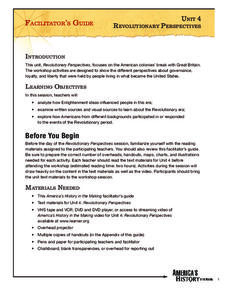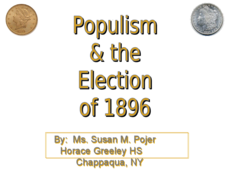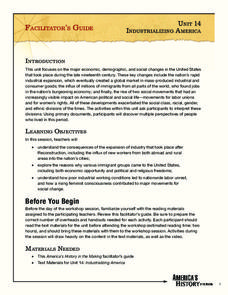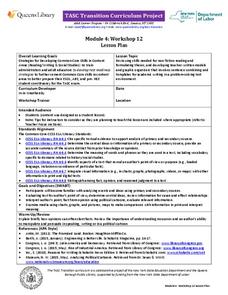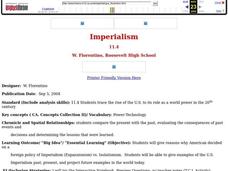Curated OER
Understanding Political Cartoons
Students draw two political cartoons. They compare the Wounded Knee Massacre of 1890 to the stand-off that took place at Wounded Knee in l973. They examine the role that Manifest Destiny played in the West.
Curated OER
It's a Draw!
Students assess the ways in which editorial cartoons, both current and historic, offer insight into events that shape our world. They create a poster that includes a current editorial cartoon and their explanation of the details of the...
Curated OER
Political Cartoons
High schoolers explain that a political cartoon is very much like an editorial--both present personal opinions. Each student writes an editorial that supports the political cartoon. They must analyze the cartoon in order to write about...
Curated OER
Editorial Cartoon: Censorship
Students explore the concept of juxtaposition. In this editorial cartoon lesson, students analyze an editorial cartoon techniques to develop an understanding of juxtaposition and symbolism used in the cartoons.
Curated OER
Cartoons for the Classroom: A Study in Early Caricatures
In this current events worksheet, students analyze caricatures of Barak Obama through the years and respond to 3 talking point questions.
Annenberg Foundation
Revolutionary Perspectives
Life, liberty, and the pursuit of happiness. Learners go to the heart of the causes of the American Revolution. Examining political cartoons, Enlightenment documents, and firsthand accounts, they present their ideas and reflective...
Carolina K-12
Revolutionary War Era Tick-Tack- Toe
So many fantastic activities on the American Revolution! From drawing political cartoons illustrating events of the Boston Massacre to writing a diary entry as a shopkeeper during the Boston Tea Party, your young historians will...
Curated OER
First World War Assessment
Here is a really neat assessment, perfect for middle schoolers who have just learned about WWI. The assessment covers the causes and effects of WWI, causes of WWII, the Treaty of Versailles, trench warfare, and key players of the war in...
Curated OER
Rebels Or Resisters?
Middle schoolers participate in a mock trial on the Whiskey Rebellion that took place in the state of Pennsylvania in 1794. They analyze the perspectives presented by both sides to determine whether the Whiskey "rebels" were guilty of...
Curated OER
Populism & the Election of 1896
Populism and the rise and fall of the Populist Party are the topics of this presentation, which details the Presidential Election of 1896 and the role of silver. Detailing main points with clever political cartoons and informative maps,...
Annenberg Foundation
Industrializing America
Imagine an eight year old spindle boy working barefoot in a factory in the late 1800s. Scholars research the industrial period in American history in the 14th lesson of a 22-part series that explores the country's background. Groups...
EngageNY
TASC Transition Curriculum: Workshop 12
How can opinions slant facts? Workshop participants learn how to examine primary and secondary sources and identify the author's point of view. They also examine how visual art impacts the meaning and rhetoric of sources. Full of...
Curated OER
Reconstruction (1865-1876)
Easily broken into pieces for several class sessions, this presentation is a great way to transition your class out of a Civil War unit and closer to the 20th century. Engaging photographs, including relevant maps and humorous political...
K20 LEARN
Between The Lines: Inferences In The Narrative Life Of Frederick Douglass Excerpt
Good literature can be much like an iceberg requiring readers to presume that the bulk of the meaning may be inferred to be found below the surface. Here's a lesson that asks scholars to conduct a close reading of passages from The...
Curated OER
Political Science: Political Analysis Through Satire
Students identify, analyze and explain examples of politcal satire. They discuss the role of political satire in the democratic process and create and present examples of political satire.
Curated OER
Smart Art
Students examine and practice the art of political cartoon-making by focusing on how and why they are so effective in making a political point.
Curated OER
Funny or Not - Your Opinion
Students interpret and judge the meaning of a political cartoon. They dicuss the cartoons in groups and write an evaluative paragraph which they present to the class.
Curated OER
Imperialism
Students explore the concept of Imperialism. In this foreign policy lesson, students examine the policies of the US and other countries through time. Students then create a political cartoon of their own and create a timeline that...
Curated OER
The Rise and Fall of Joseph McCarthy
Students analyze documents, cartoons, speeches and articles about Joseph McCarthy and his crusade against "Un-American" activities. They guide their research with a worksheet and participate in class discussions about their findings.
Curated OER
Read All About It!
Students research and develop a newspaper based on the day they were born. In this newspaper lesson, students write an editorial, look for a political cartoon, draw a visual and find music from that year. Students type their...
Curated OER
"Black ans White": Nineteenth Century Racism
Students examine Thomas Nast's illustration, "Black and White," looking for examples of racism. Contemporary stereotypes utilized to demonstrate the attitudes of people in the North and South in the 1800's are explored.
Curated OER
Using Primary Sources to Discover Reconstruction
Fifth graders discover how reconstruction had an impact on racial issues in the United States. In this Reconstruction lesson, 5th graders are introduced to primary vs. secondary resources and then rotate through stations to view...
Curated OER
The Election of 1896 - Gold or Silver?
Students analyze the issues behind the Election of 1896 and describe the positions of William McKinley and William Jennings Bryan. They evaluate editorial cartoons supporting McKinley's candidacy via editorial cartoons. Each student...
Curated OER
Americans Settle in Texas and Life in Early Texas
Students participate in a layered curriculum unit that includes: Create a political cartoon about the effect of the Mexican colonization laws on Texas settlement. The cartoon should be from the point of view of a Tejano. Write a caption...







